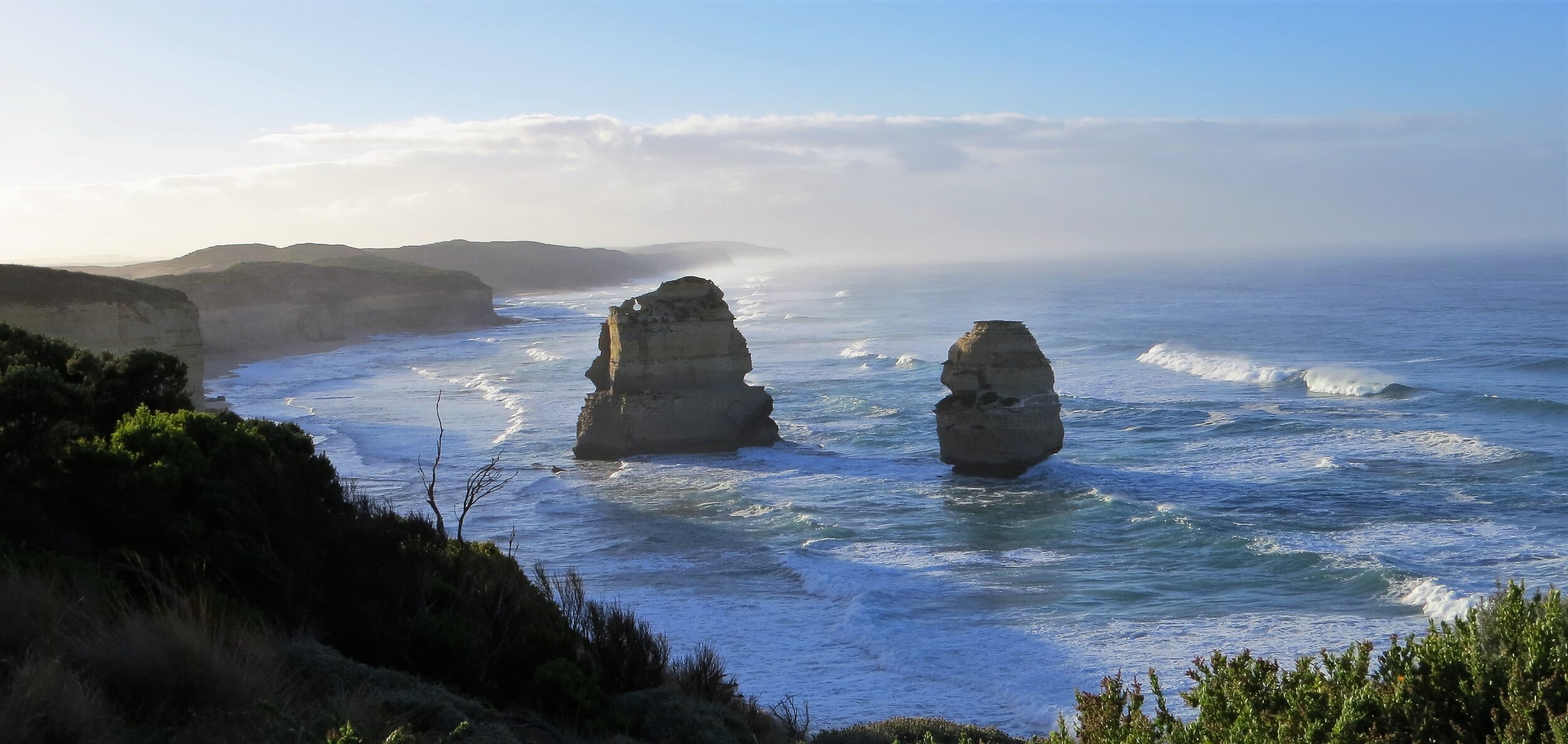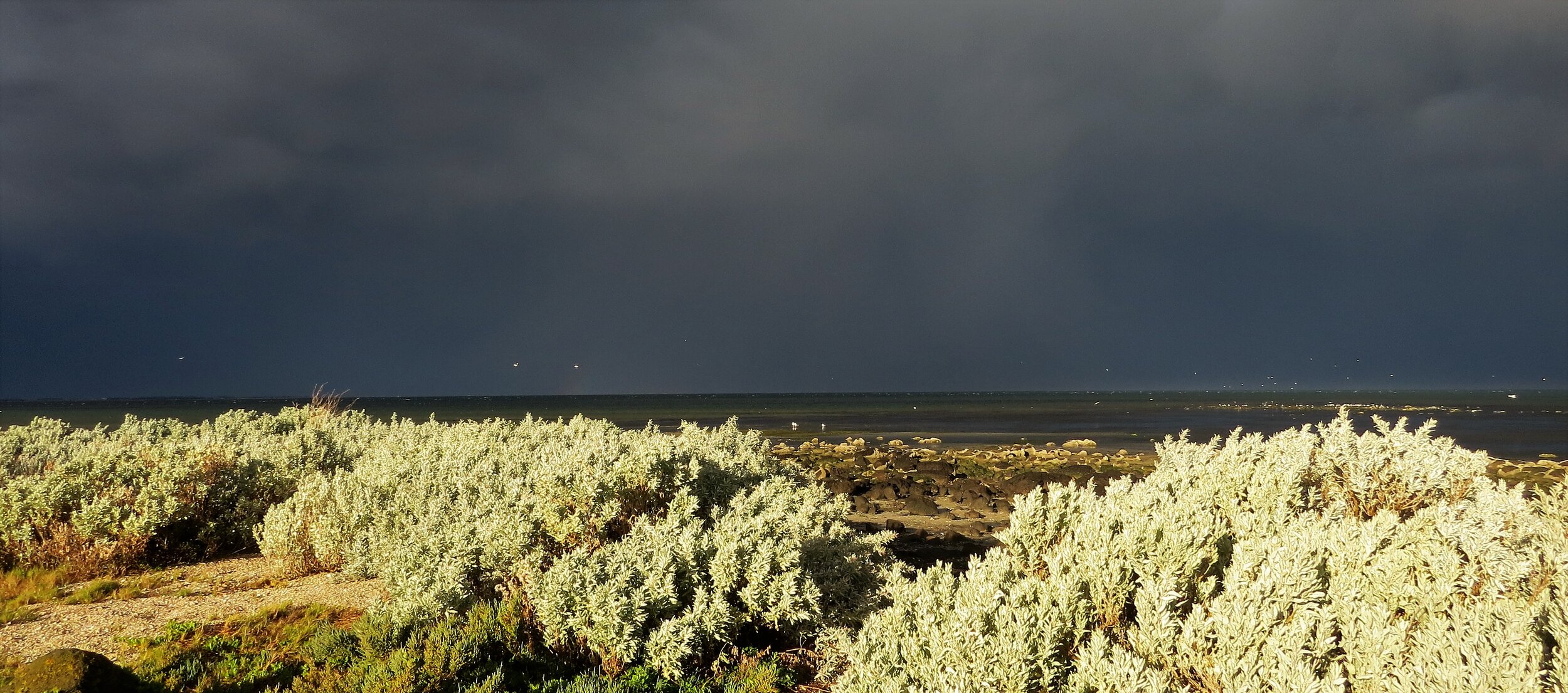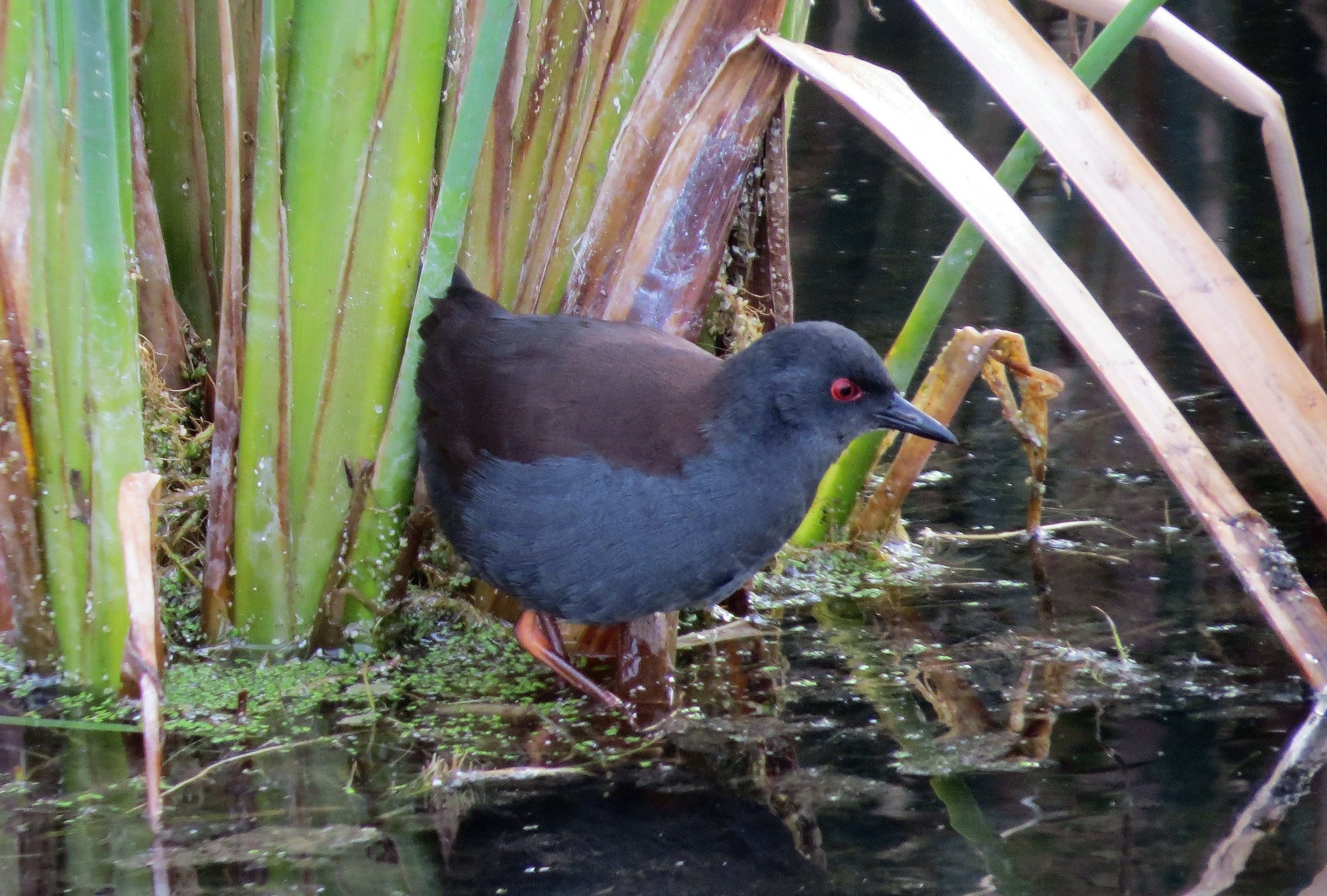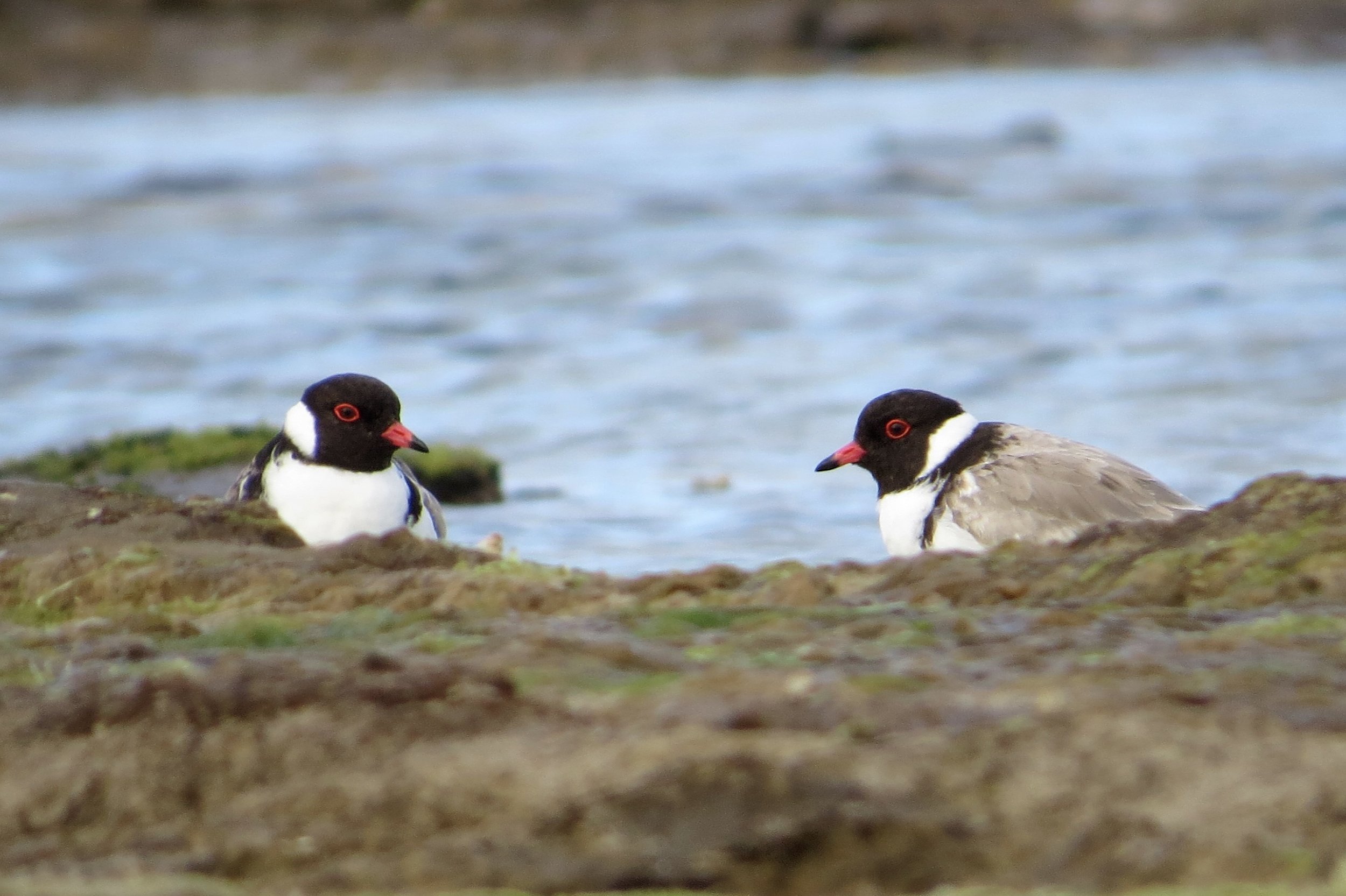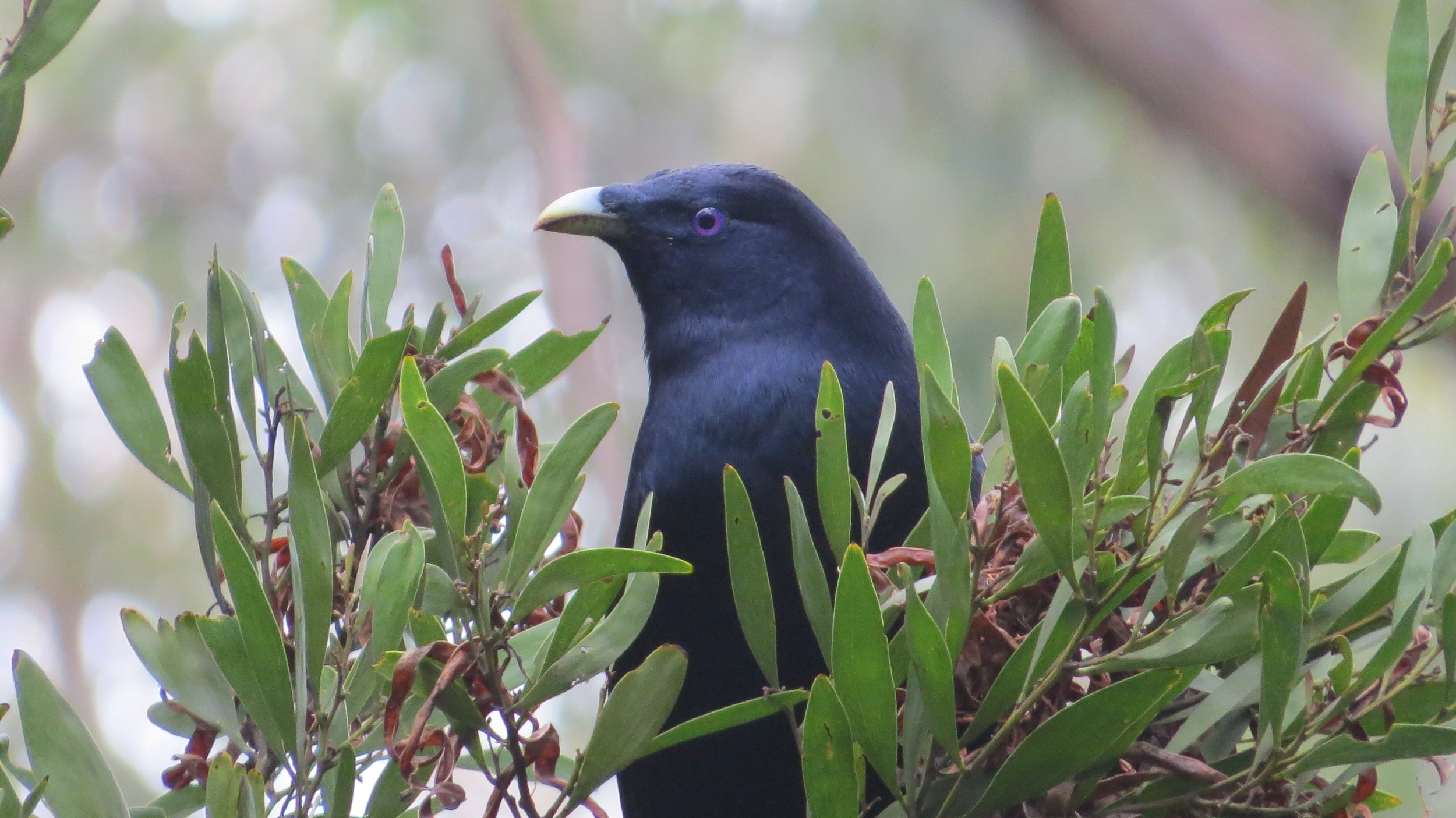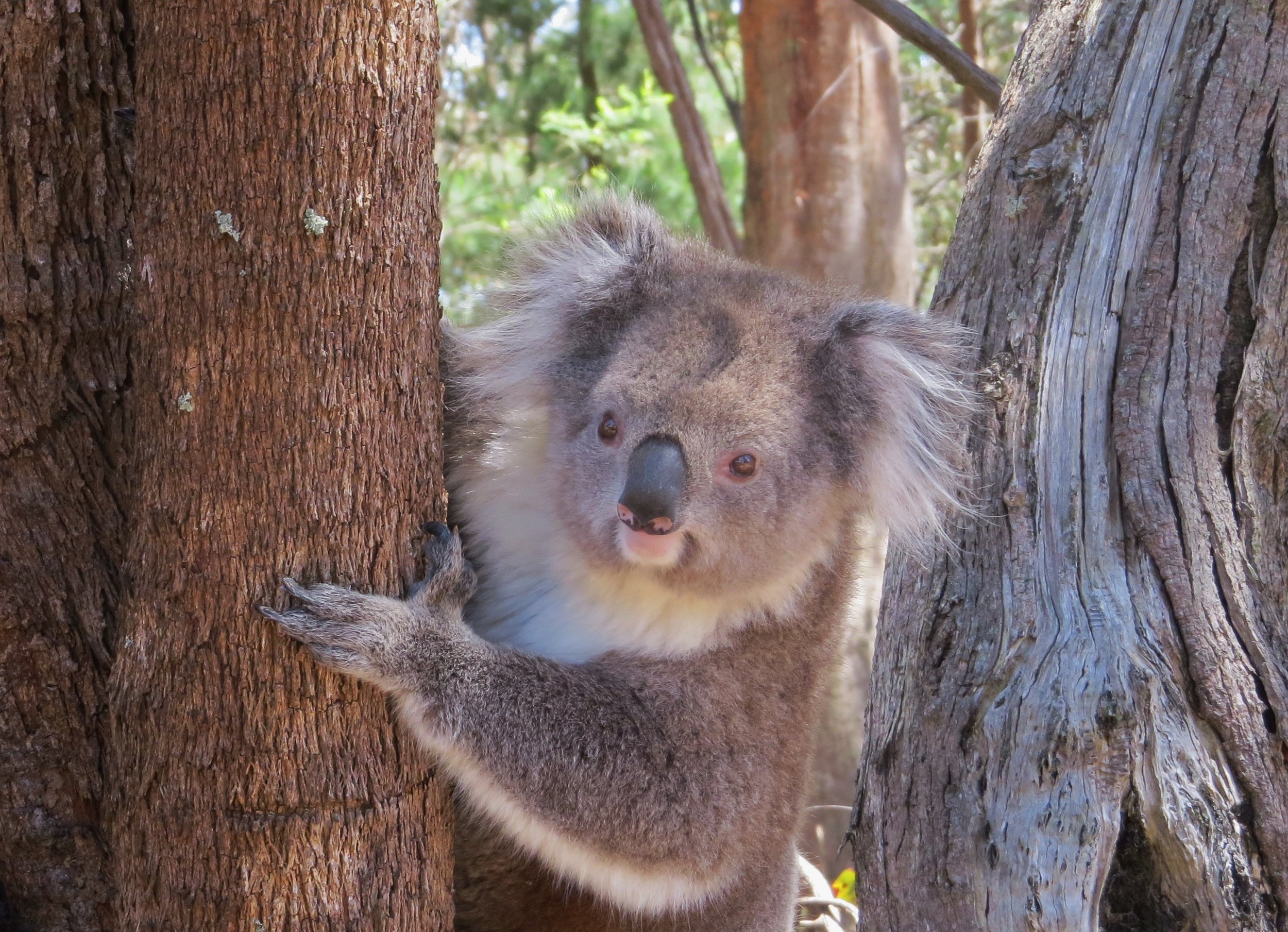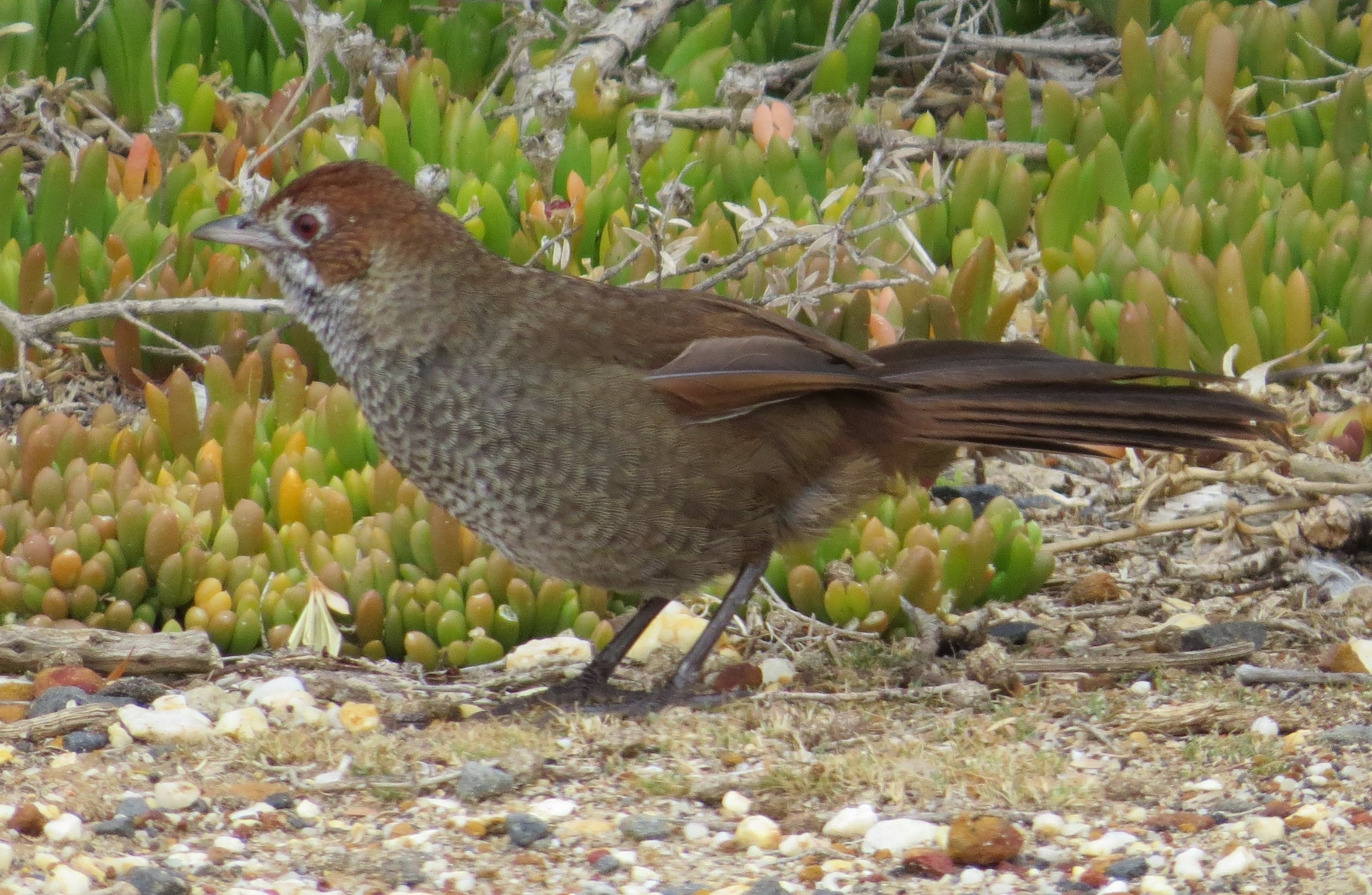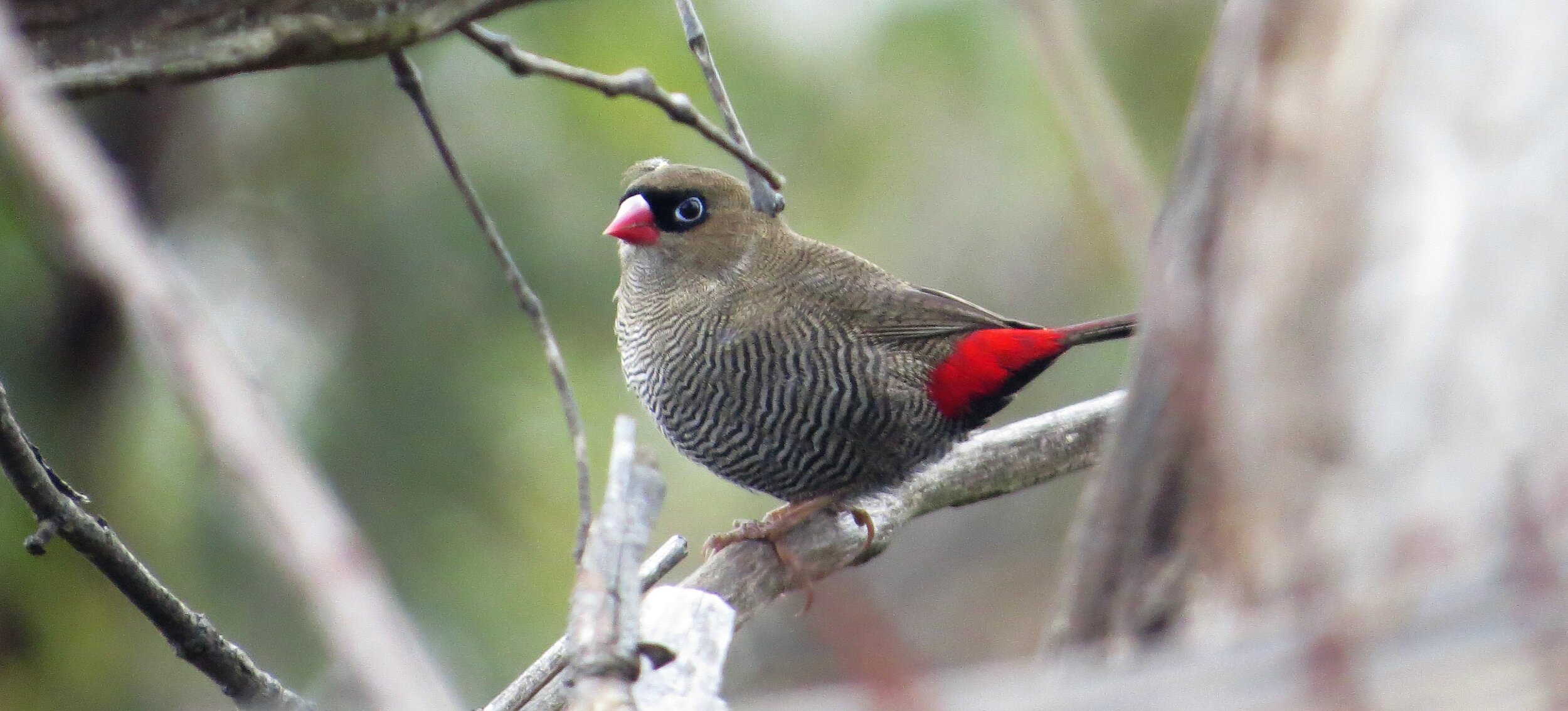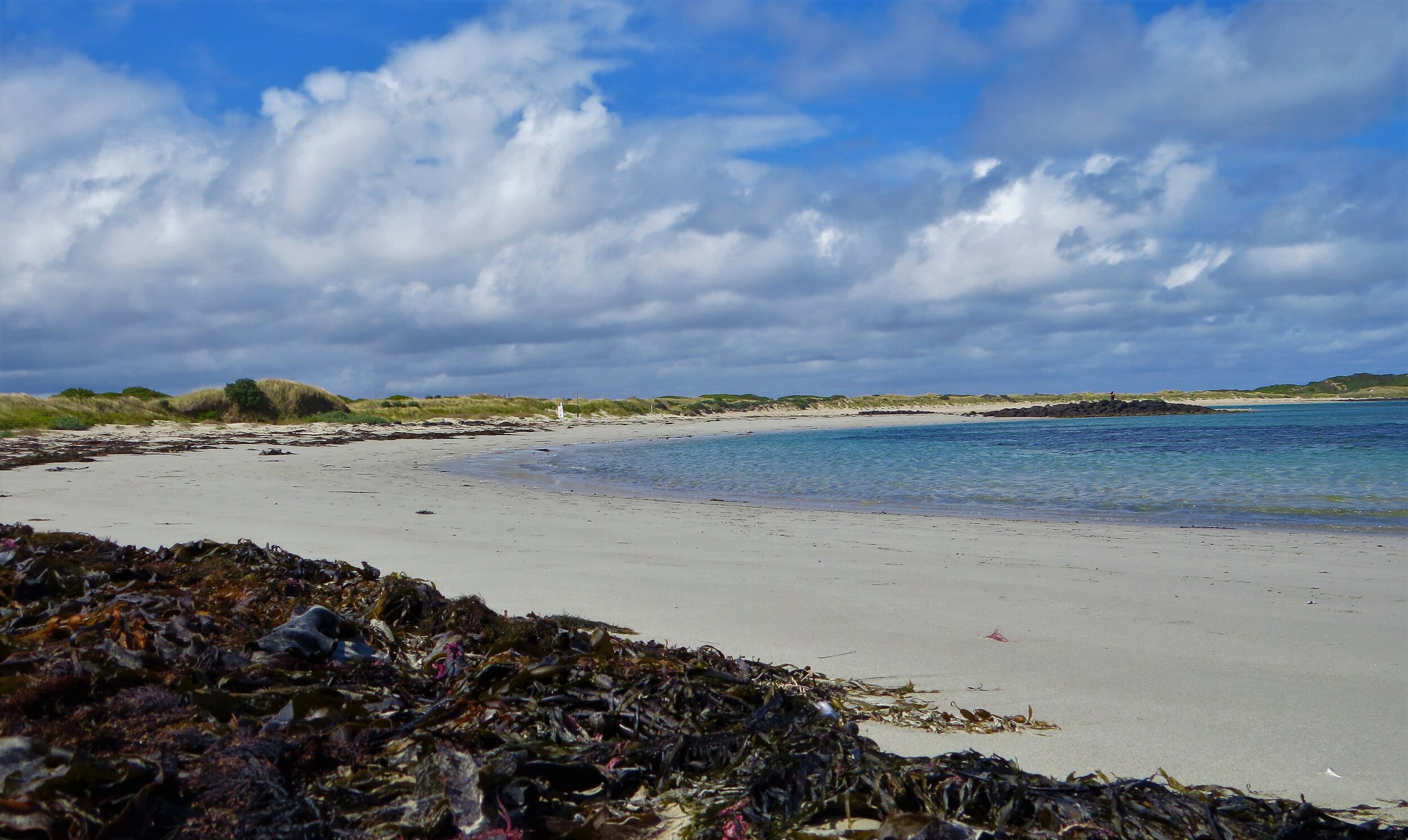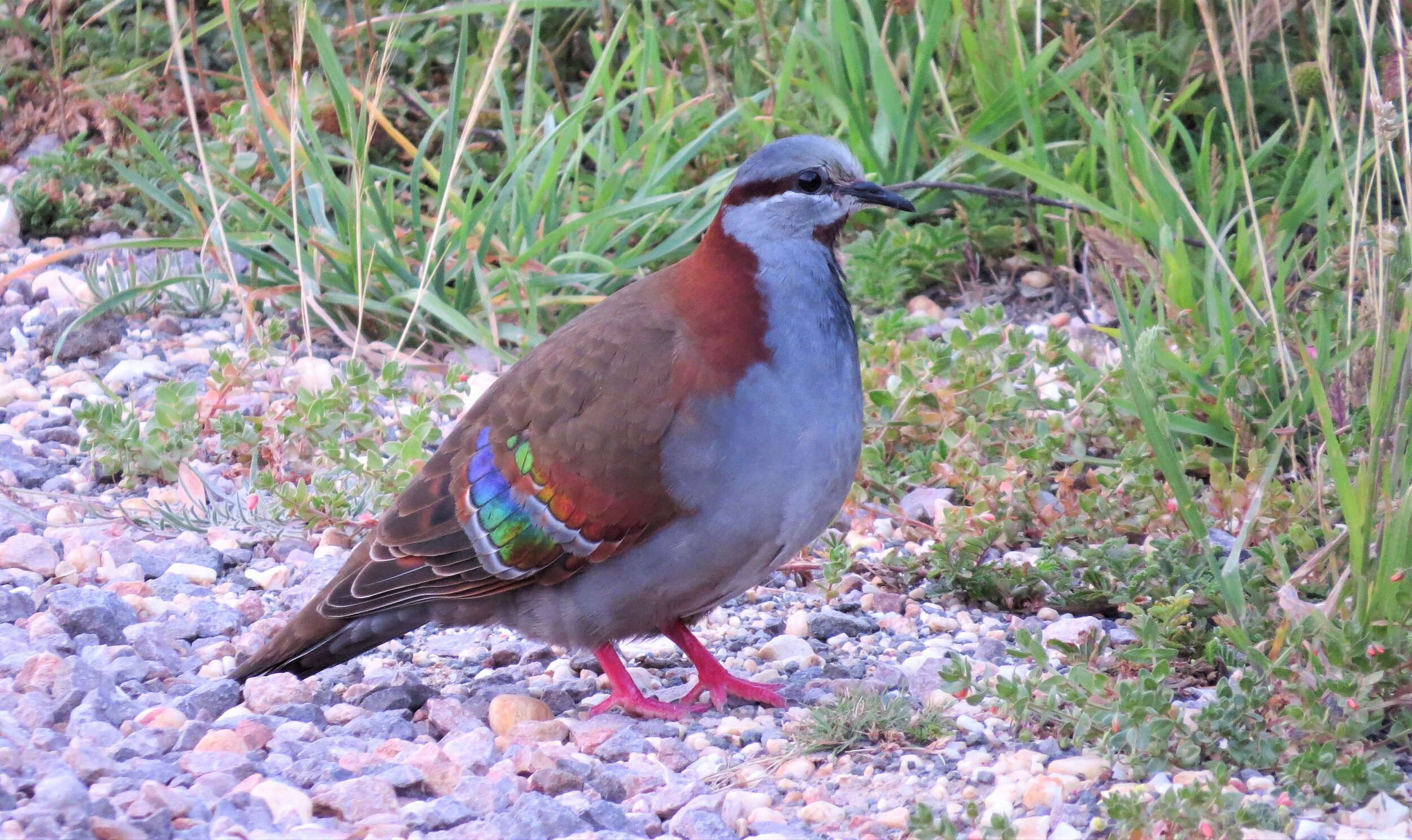From Melbourne across to the South Australian border and inland to the Grampians and the Little Desert, this part of Victoria has some of the most scenic and floristically diverse areas in the state. The Great Ocean Road attracts tourists from around the world, whilst the diversity of habitats especially in the Greater Otway NP, and the various parks and reserves in far South-west Victoria are a must for birders. The endemic Rufous Bristlebird is only found in western Victoria and adjacent South Australia near the coast, and with the diversity ranging from the Great Southern Ocean, rocky coastlines, estuaries, coastal heathlands, eucalypt woodlands, tall wet eucalypt forest and cool temperate rainforests this part of VIctoria is second only to Gippsland in its diversity of experiences.
GEOLOGY :
Western Victoria has one of the world’s great basalt plateaus, some 15,000 sq kms stretching from Melbourne out to South Australia, with some 3-400 different volcanic eruption points. The most recent lava flows in Victoria are dated at around 6000 years old, with even more recent ash deposits in adjacent South Australia. Aboriginal occupation in the area is proven to at least 30,000 years ago. The lava flows buried existing soils and vegetation, with relatively few treed areas remaining. Flow thickness is rarely more than 50 metres in depth, and resultant ash deposits have created fertile soils.
The Otway Ranges, closer to the coast, consist of older Cretaceous period rock formations (100 to 140 million years ago). At the time of the separation of Australia and Antarctica, landlocked basins formed in the large trough at the junction of the continents, accumulating sediments for around 50 million years with wind and water erosion contributing to a dynamic system. The result was the shale, mudstone and sandstones of the Otway ranges which are rich in fossils of the early Cretaceous period.
The Otway plains are formed from marine sediments in the Tertiary period and extend up to 50 kms inland. The eroded sandstone coastlines of the Great Ocean road are world famous
The south western section of the region abutting South Australia and inland from the coast, called the Wannon, is quite distinct and formed from marine sediments, a coastal plain of calcareous sand ridges, and in weathered areas gravel and ironstone occur near the surface.
Lastly the isolated Grampians deserve their own mention. A result of folding and faulting of Devonian quartose sandstones.
CLIMATE :
Much of Western Victoria receives between 500 and 1000 mms of rainfall annually with the higher totals closer to the coast and in hilly country. The two exceptions to this are firstly the higher mountain ranges of the Otways, the Grampians and the Daylesford/Trentham/Macedon ranges which receive in excess of 1000mms particularly the highest parts of the Otways which receive 1500 - 1800 mms. And secondly there is a rain shadow area on the plains between Melbourne and Geelong which also includes the You Yangs Regional Park where annual rainfall is less than 500 mms.
Rainbow over a coastal heathland
Temperatures though the region are generally moderate, however as with anywhere in Victoria, extremes of summer heat and winter cold occur but they are not as prolonged or as extreme as further inland (heatwaves) or in the higher mountains of the Australian Alps (cold spells). Seasonally there can be plenty of wind, mostly in the SW quarter, and many wind farms have been constructed.
VEGETATION TYPES :
As mentioned in the introduction this large region has many different habitat types depending on the soil and climate.
The recently formed Volcanic plains and the resulting savannah plain volcanic woodland with its native grasslands of Themeda, Danthonia and Stipa was quickly obliterated after white settlement when sheep grazing and cropping were introduced. Some laval ridges and crater areas were too stony to be ploughed and retain some of their features to this day. Trees and shrubs generally are either absent or restricted to watercourses, swamps and rocky hills and slopes bordering the plains. The tussock grasslands held many perennial and annual flowering plants, one of which, the Yam Daisy (“Myrnong”) was especially important as a source of starch, from its tubers, for local Aboriginal peoples and was abundant until the sheep arrived. Tall windbreaks of introduced Pinus and Sugar Gum throughout the western plains have completed the annihilation of the original floral landscape. The region does however have many hundreds of waterbodies from small ponds to vast lakes.
The coastal plains consist of damp eucalypt forest, dry eucalypt forest and heathlands. The heathlands are of particular interest for their diverse flora and some specialist bird species. Dominant plants, mostly under 2 metres in height include varieties of Leptospermum (Tea-tree), Acacia (Wattles), Allocasuarina (She-oaks), Gahnia (Saw-sedges), Ozothamnus (Everlasing bushes), Hakeas (Needlewoods), Banksias, Bossiaea, Dillwynia (Parrot-peas), Goodenias, Epacris (Australian Heaths), Xanthorrea (Grass-trees) and Melaleucas to name a few. As with many plant communities fire is an important tool in maintaining diversity in the landscape. Left unburnt for decades gradually eucalypts take hold and open heaths are reduced. A great diversity of terrestrial orchids grow in the region
Wallflower Orchid, Diuris orientis
In the Otway Ranges, fertile soils and high rainfall support wet sclerophyll forest of extremely tall (40 m plus) straight growing eucalypts such as Mountain Ash (E.Regnans), E. Globulus (Blue Gum), and E.Obliqua (Messmate, perhaps the commonest tree in both wetter and drier sites). Other common trees generally include E.Viminalis (Manna Gum, a favourite food for Koala), E.Ovata (Swamp Gum) , and in drier sites E.Radiata (Peppermint), E. Baxteri (Brown Stringybark). On protected slopes at higher elevations where rainfall exceeds 1200mms cool-temperate rainforest occurs . This closed forest is dominated by Nothofagus cunninghamii (Myrtle Beech) and Blackwood (A.melanoxylon). Shrub and herb layers are limited due to low light levels, but fern communities are common and diverse at the ground layer. Nothofagus turns up in fossil records widely in Australia after separation from Antarctica in the early Tertiary period and when Australia was a much wetter place even far inland some 10-30 million years ago.
Wooded heathland communities across the Wannon are typically formed of widely spaced and lower growing trees. Extensive areas of Brown Stringybark are home to the endangered South-Eastern Red-tailed Black Cockatoo. River Red Gum communities are common in wet sites, whilst Manna Gum, Yellow Gum, Swamp Gum and Messmate also form their own communities where the soil types are right.
SITE DESCRIPTIONS :
The Bellarine Peninsula
As with the coastline closer to Melbourne, the Bellarine peninsula has many worthwhile birding sites within a small area. It is a good area for shorebirds with reasonable diversity present at various sites. It also has freshwater marshes where in season rails, crakes and Bitterns may be seen. On top of this coastal lookouts will reward with ocean going seabirds such as Shy and Black-browed Albatross.
Getting there: It takes one hour to drive to Geelong from Melbourne on the Princes freeway. From Geelong either head south on the Barwon Heads road, or south east on the Bellarine highway.
Key sites: Belmont common in Geelong is a good place to try for some of the trickier marshland birds, such as Latham’s Snipe and Spotless Crake especially when water levels have dropped in summer.
Breamlea to Barwon Heads. The coastline and adjacent marshes here are good shorebird habitat. Point Impossible, Black Rock and Thirteenth beach are all interesting with localised coastal species such as Pacific Golden Plover, Hooded Plover and Sanderling all regular. Seabirds may be seen off shore and Black-faced Cormorants can be in the area. The marshes adjacent to Blackgate road and Minya road hold a range of waterbirds when water levels are right. Seabirds may be seen especially from Barwon heads bluff.
Lake Connewarre is a complex of wetlands at the end of the Barwon river, some of which is tidal. Waders are found in the estuary at Barwon heads and particularly in the lower reaches of the lake. Either access from Taits road or Brinsmead lane on the northern shore. The saltmarsh also has some interesting birds such as Blue-winged Parrot and Southern Emu-wren. Reedy lake is the freshwater part of the system further upstream. Hospital swamp, accessed from Hospital swamp road is a good wader hotspot on the southern side especially when water levels have dropped in summer and autumn or access from Moolap station road, Woods road or O’Halloran road on the northern side.
Lonsdale lakes are two shallow brackish wetlands that can hold large numbers of waders again particularly when water levels drop through summer. Access from Emily st or Clows lane. This is one of the only places in Victoria where Hooded Plovers may be seen away from the beach.
Edwards Point and Swan Bay on the eastern end of the peninsula are also excellent for waders and various coastal birds, with saltmarsh and mudflats exposed at low tide. Allow two or three hours for the return walk to the point, access from the east end of Beach road, St Leonards.
Lake Lorne reserve and the nearby Drysdale lakes, either side of High St in Drysdale are interesting freshwater lakes which regularly hold high numbers of Freckled Duck, especially in summer.
Key Species: Brolga, Australasian Bittern, Black-faced Cormorant, Shy Albatross, Hooded Plover, Pacific Golden Plover, Sanderling, Wood Sandpiper, Pectoral Sandpiper, Spotless Crake, Latham’s Snipe, Fairy Tern, Double-banded Plover, Freckled Duck, Blue-billed Duck
The Otways and the Great Ocean Road
With moisture laden air coming in off the Great Southern Ocean meeting steep mountain ranges which go right down to the coast, the Otways region receives some of the highest rainfall in the state. The resulting lush towering forests of Blue Gum and Mountain Ash are simply magnificent, and in the higher areas cool temperate rainforest and spectacular waterfalls complete the scene. Add to that the coastal heathlands that occur around Anglesea and Aireys Inlet as well as in the Port Campbell National Park and you have a tremendously diverse birding area, complete with its own speciality, the very localised endemic Rufous Bristlebird. Separation from the similar environments of the Great Dividing Range throughout Gipplsand by the flatter volcanic plains west of Melbourne has been long lasting and despite suitable habitat birds such as the Superb Lyrebird do not occur, however the Satin Bowerbird, being a more mobile species did make it across.
Getting there: Driving from Melbourne there is now a bypass around the city of Geelong, which means you can be on the coast near Torquay in not much over an hour. Then simply follow the scenic coast road, remembering to keep looking ahead at the road and not get too distracted by the spectacular scenery. There are many tourist coaches passing through every day, but little in the way of public transport.
Key sites: In order from the Melbourne end of the coast road through to Port Campbell the first worthwhile stop is Point Addis. A short drive off the main road takes you to a scenic lookout which is a handy sea watching site with Shy Albatross almost guaranteed and many other possibilities depending on the time of year and the weather. Rufous Bristlebird and Brush Bronzewing are found here. It is also worth stopping at the small car park closer to the highway where a walking track takes you along the ridge and/or down into Ironbark basin. The Ironbark and Stringybark woodland here has lots of birds such as Cuckoos in spring, Scarlet Robin, Satin Flycatcher, Olive-backed Oriole, Grey Currawong, etc.
Anglesea Heath – Either access along Forest road on the eastern edge of the reserve where various tracks allow access or take Harvey street which climbs the hill behind the west end of town. Once up on the heath Bald Hills road or No.2 road are both good tracks to try. Coallmine road which runs around the back of town at the bottom of the hills is good for birding but currently a no through road. Another worthwhile section of heath is adjacent to the coastline just east of town, park at the end of Purnell st and walk along the cliff top. The heathlands are very rich botanically, and have some specialist birds such as Southern Emu-wren, Tawny-crowned Honeyeater, Striated Fieldwren, Blue-winged Parrot, Chestnut-rumped Heathwren, Beautiful Firetail (rare) , Rufous Bristlebird and Olive Whistler. They are also very good for Gang Gang Cockatoos which regularly come into town.
Coogoorah Park has some nice walks close alongside the Anglesea river, access via River reserve road. Gang-gangs and Yellow-tails are often seen flying by, Crested Shrike-tit, Blue-winged Parrot, Southern Emu-wren, Little Grassbird, Latham’s Snipe and Buff-banded Rail all occur here and Lewins Rail may be seen if lucky
The mixed habitats behind Aireys Inlet are also excellent, with Bambra road, Distillery Creek road and the Old Coach road particularly good access points. Distillery Creek car park has a small waterhole attractive to birds in the summer and further east Distillery Creek road goes past a reservoir with Musk Duck and Hoary-headed Grebe. At the eastern end of the reservoir some smaller pools also attract bush birds to drink in summer. . Moggs Creek picnic area to the west of Aireys is a peaceful location and has a well formed nature walk.
The Split Point Lighthouse at Aireys Inlet is another headland good for seabirds, and also Rufous Bristlebird. The small pond at the start of the access road can have Latham’s Snipe in summer, and also Buff-banded Rail.
The endangered Hooded Plover occurs all along the coastline in small numbers, check any suitable looking ocean beach. Fenced off areas protect the birds when breeding.
Lorne- Drive up into the mountains behind Lorne and you hit the first of the towering eucalypt forests, with Gsng-gang Cockatoo, Satin Bowerbird and King Parrot, and a good chance of Koala. Worthwhile sites include the Allenvale road along to Allenvale Mill and the She-Oak picnic ground, Sharps track, the Erskine Falls road up to Blanket Leaf picnic area and the Falls themselves. For a scenic drive continue along the Erskine Falls road to the end, turn right onto Benwerrin Mt Sabine road and then right again on the Lorne Deans Marsh road to return to Lorne. Also Five mile track (walking only) accessed off the Deans Marsh road is quite birdy. Species to look for include Bassian Thrush, Forest Raven, Gang Gang Cockatoo, Olive Whistler, Crescent Honeyeater, Satin Bowerbird, Flame Robin, Rose Robin, Rufous Fantail etc. The forest here comes alive at night, with many nocturnal mammals to see as well as a chance for Powerful Owl or Masked Owl.
Moving further west into the Otways the township of Kennett river is an excellent place to see Koala especially along the first couple of kms of Grey River road. Triplet Falls would be one of the most magnificent walks in a cool temperate rainforest with Pink Robin a real chance whilst the nearby Hopetoun Falls and Beauchamp Falls also provide opportunities to see Pink Robin. The road out to Cape Otway has a Koala population and Blanket Bay is well worth the detour with its mix of stringybark woodland and rich coastal heathland, a very birdy spot and a chance for Beautiful Firetail.
A little more inland between the townships of Gellibrand and Carlisle river, the Old Carlisle Track is a four wheel drive track which is seasonally closed in winter. The sandy nature of the soil here supports a diverse heathland and is an excellent area to look for Southern Emu-wren, Beautiful Firetail, Olive Whistler and lots more. Either drive in with care, or park at either end and walk.
Further west still in the Port Campbell NP, the scenery ramps up even more with eroded sea cliffs, and the many arches and pillars that make this area so famous. It also happens to be excellent for seeing Rufous Bristlebird, at many of the tourist car parks along the way, best in the early morning before all the regular tourists wake up. From the tip at the back of Port Campbell follow Fireline track, 4WD recommended for Rufous Bristlebird, Brush Bronzewing, Beautiful Firetail and Southern Emu-wren.
There are of course many more worthwhile spots in this rich area, which is great to explore.
Key Species: Black-faced Cormorant, Shy Albatross, Black-browed Albatross, Forest Raven, Rufous Bristlebird, Gang Gang Cockatoo, Satin Bowerbird, Pink Robin, Olive Whistler, Southern Emu-wren, Blue-winged Parrot, Tawny-crowned Honeyeater, Powerful Owl, Masked Owl, Beautiful Firetail, Chestnut-rumped Heathwren, Bassian Thrush, Brush Bronzewing, Flame Robin, Rose Robin and Crescent Honeyeater amongst others
Western District Lakes
Inland from the coastal strip and south of the dividing ranges many hundreds of wetlands exist in the volcanic plains bio-region. With the region’s reliable rainfall these lakes do not dry up as frequently as more inland lakes, but during summer and when there are drought conditions, their water levels do drop and they can become magnets for huge numbers of waterbirds. Even in winter they are important sites for many species. Surrounding country has a range of birds of prey plus grassland and farmland species. This part of Victoria is a stronghold for the Brolga. Following are descriptions of some of the more important wetlands
Double-banded Plover acquiring breeding plumage
Lake Modewarre: This fairly large slightly brackish lake east of Winchelsea can be accessed via a number of dead end roads on the NW, SW and SE sides of the lake. The lake shore is open and as water recedes the birds may be quite distant requiring a fair bit of walking, but its worthwhile as a wide variety of waterfowl and wading birds use the area especially in spring and summer. Red-necked Avocet and Banded Stilt may be present as well as a variety of migratory sandpipers. In winter it plays host to Double-banded Plovers from New Zealand and Blue-winged Parrots feed amongst the lake shore vegetation. A Northern Shoveler was a recent rarity here.
Lake Murdeduke: North-west of Winchelsea access is either via a gated but public track off the Cressy road, or from the end of Block lane. This lake is a similar size to Lake Modewarre, and attracts very similar species though it is perhaps even better for shorebirds. Some quite large flocks of Blue-winged Parrots can winter here, and shorebird numbers can be quite high, with a number of rarities found over the years such as Long-toed Stint, Buff-breasted Sandpiper,Red-necked Phalarope, Little Curlew and Pectoral Sandpiper.
Wintering flock of Blue-winged Parrot
Lake Colac: A large open shallow lake just north of the town of Colac, there are some worthwhile places around its shoreline for birding. At the end of Church st in Colac you will reach the Colac Bird Sanctuary on the south shore of the main lake. Some freshwater marshes are excellent habitat here, good for Lathams Snipe, plus shorebirds and crakes may be seen when the water levels are right. Australasian Bittern and Intermediate Egret appear from time to time, and views can be had of the main Lake where large numbers waterbirds can gather such as Spoonbills, waterfowl including Freckled Duck, Stilts and Sandpipers, Whiskered Terns and Ibis. On the west side of the lake Delaneys road provides good access and at the northern end Meredith Park provides views also.
Lake Martin and Cundare Pool: These large lakes just south of Cressy can be viewed either from the Colac-Ballarat road or from other local roads. Close viewing is not possible with private lands all around but fairly reliable for Brolga and Cape Barren Goose. Lake Rosine which is just west of cressy is worth a look also attracting waterfowl and shorebirds.
Lake Elingamite: This smaller lake near Cobden, accessed via Oates road, is good for Musk Ducks, Egrets and Spoonbills, plus surrounding habitats support a range of bush birds. There is some cover for Rails and Crakes also.
Lake Purrumbete: This quality fresh water lake near Camperdown is excellent for a wide range of ducks and Grebes such as Musk Duck, Blue-billed Duck, Freckled Duck, Magpie Goose, and Great Crested Grebe, and again there is cover for Rails and Crakes.
Bryans Swamp: North-west of Dunkeld at the bottom of the Grampians this shallow freshwater wetland can be viewed at some distance from McIntyres Crossing road. Egrets, Whiskered Terns and Pied Stilts feed in the shallows and Emus and Brolgas are both regular sightings.
Lake Linlithgow: This is a jewel of a wetland, just east of Hamilton, and can be excellent for migratory shorebirds (significant numbers) when water levels are dropping, plus attracts the full range of waterfowl, Brolgas, Avocets, Stilts and marsh Terns. The surrounding area attracts a variety of bush birds as well. Nearby Bullrush Swamp and Krause swamp are also valuable habitats but access is not easy.
Lake Wendouree: In the heart of the city of Ballarat is very popular place with the locals, and has some excellent natural values. The most interesting section is the north-west quarter, where Musk and Blue-billed Duck may be seen at close range plus Great Crested Grebes and Reed Warblers. Ibis breed on islands here, and extensive beds of rushes and reeds support Swamo Harriers, Spoonbills, Whiskered Terns, Night-herons and sometimes Magpie Geese.
Mullawallah Wetlands (Winter Swamp): Just out of Ballarat to the west, access via Lucas Lane off Remembrance Drive. This is a beautiful healthy wetland with nice access on a walking track. As with other well vegetated wetlands, best birding is when water levels are dropping, when Rails and Crakes can appear here in good numbers. Also good for Latham’s Snipe, Black-tailed Nativehen, Blue-billed Duck and Brolga
Pelagic Sea-birding Trips
Wandering Albatross, Diomedia Exulans (“Snowy” Albatross)
Southern Australia has some of the best pelagic birding in the world. The list of ocean going seabirds seen in Victorian waters is very long, and a day out on the water at any time of the year is sure to produce something of interest.
Monthly boat trips from Port Fairy in far south-west Victoria are organised by Birdswing Wildlife Tours http://www.birdingwildlifetours.com.au/index.php?page=tours&subpage=portfairy Bookings should be made well in advance, and these trips are very popular. You are also able to put your name down on a waiting list, as frequently when the week comes some cannot make it. Some trips do not get out due to rough weather in which case a second attempt may be made the following weekend.
Key Species: Regular species seen depending on the season include Australasian Gannet, Little Penguin, Shy Albatross, Black-browed Albatross, Yellow-nosed Albatross, Wandering Albatross, Antipodean Albatross, Southern Giant-Petrel, Northern Giant-Petrel, White-chinned Petrel, Great-winged Petrel, Wilson’s Storm-Petrel, White-faced Storm-Petrel, Grey-backed Storm-Petrel, Cape Petrel, Fairy Prion, Common Diving-Petrel, Fluttering Shearwater, Flesh-footed Shearwater, Short-tailed Shearwater, Huttons Shearwater, Sooty Shearwater and Crested Tern.
Other seabirds recorded each year but less frequently include Sooty Albatross, Buller’s Albatross, Royal Albatross, Gould’s Petrel, Soft-plumaged Petrel, White-headed Petrel, Slender-billed Prion, Antarctic Prion, Brown Skua, Arctic Jaeger, Pomarine Jaeger and White-fronted Tern.
Then there is a long list of rarer and vagrant seabirds making these trips some of the most exciting pelagics in the world
Shy Albatross and Great-winged Patrel
South-Western Victoria
The south-west corner of Victoria is an under visited region with outstanding natural values, and a high percentage of native vegetation intact. Port Fairy and Portland are well known as coastal towns from which pelagic birding trips leave, however the region offers much much more. Lake Condah is the site of elaborately engineered eel traps constructed by Aboriginal peoples and dated over 6000 yrs old. In winter Southern Right Whales may be seen off Warrnambool. The high rainfall has meant this district is valuable farming land, with drainage schemes having reduced the number of wetlands. More recently wetland values are being recognised for their wildlife and cultural values with rehabilitation taking place at various sites. Heading away from the coast around the towns of Dartmoor, Casterton and Edenhope, many bushland reserves remain, with this being the stronghold of the endangered South-East Australian Red-tailed Black Cockatoo.
Getting there: The region lies some 380 kms west of Melbourne via the Princes Highway, which continues on to the coast of South Australia.
Key sites: Portland: Cape Nelson is probably the best land based site for viewing seabirds in Victoria. As well as the seabirds that frequent coastal waters, at times pelagic seabirds are observed here especially in rough weather. Add to that prime coastal heathland with Rufous Bristlebird, Beautiful Firetail, Blue-winged Parrot, Brush Bronzewing and Olive Whistler and you have yourself hours of amusement.
Point Danger Gannet colony: A viewing platform just outside the protective fence allows for observation of nesting Australasian Gannets. Individual Cape Gannets have been recorded here on and off for many years. Contact the Portland visitor centre for access
Portland Harbour may provide close viewing of seabirds, particularly during winter in rough weather.
Fawthrop lagoon in town has some quality wetland values. When water levels are lower Lewins Rail may be observed from the boardwalk. Australasian Bittern may occur in winter.
The newly declared Cobboboonee National park 10 kms north west of Portland is a site with some quality wet forest gullies important for species such as Powerful Owl, Rose Robin, Olive Whistler, Satin Flycatcher, Rufous Fantail, Bassian Thrush and Pink Robin (in winter). In the northern section Spotted Quail-thrush occurs. There is also a population of the rare and enigmatic Masked Owl here.
Port Fairy: Griffiths island has a colony of Short-tailed Shearwaters (try a dusk walk in summer), and Hooded Plover occur on some of the beaches here. Wetlands on the south side of town along Ocean drive, Powling Street and the Moyne river are important for Latham’s Snipe in summer and Australian Spotted Crake is regular here. Killarney Beach is worthwhile with Kelp Gull, Turnstone, Sanderling and Hooded Plover all regular.
From Yambuk, 17kms west of Port Fairy take Lake road and then walk to the Eumerella river mouth, where waders roost at high tide. Hooded Plover and Sanderling may be seen. Ephemeral wetlands along Lake road add further interest.
Deen Maar is an important area for a number of threatened species, with river flats, saltmarsh, and coastal dunes at the west end of Lake Yambuk. For access contact the traditional owners, who run the Eumeralla Backpackers. At times Lewin’s Rail, Australasian Bittern, Lathams Snipe, Southern Emu-wren, Stilts, Avocets and Crakes may be seen. It also was a traditional site for wintering Orange-bellied Parrot, though these have been rarely observed in recent years.
Nelson: Discovery Bay, between Portland and Nelson is a stunning 30+km long ocean beach with Hooded Plovers.
The Glenelg river estuary at Nelson is worth a look for waders and terns. Adjacent coastal dunes have Brush Bronzewing, Olive Whistler and Beautiful Firetail amongst others. Access from Nelson via Beach road.
The Lower Glenelg National Park preserves the lower reaches of this river, where steep gorges are popular for canoeing. Azure Kingfisher, Olive Whistler, Rufous Bristlebird, Gang Gang Cockatoo, Brush Bronzewing, Emu, Blue-winged Parrot and Crescent Honeyeater all occur here. In the eastern section of the park wet heathlands are home to Southern Emu-wren. The near impossible King Quail has been recorded here and Red-tailed Black-cockatoos are regularly seen at Princes Margaret Rose Caves
Inland from the coast : between Portland, Dartmoor, Casterton and Edenhope lie large areas of forest and scrub, plus many wetlands with tremendous values. Little visited this section of Victoria is quiet and wild, with a wide range of birds. Sites include Stokes River State Forest and Crawford River Regional park north-east of Dartmoor. Nangeela State Forest, Drujurk SF, Bahgalluh SF and Argyle SF west of Casterton. And between Casterton and Edenhope lies Dergholm State Park, Dorodong SF, Roseneath SF and Tooloy-Lake Mundi Nature reserve.
This region provides important Victorian habitat for Emu, Australasian Bittern, Musk Duck, Swamp Harrier, Brolga, Red-tailed Black Cockatoo, Yellow-tailed Black Cockatoo, Blue-winged Parrot, Spotted Quail-thrush, Southern Emu-wren, Chestnut-rumped Heathwren and Forest Raven.
Key Species: Emu, pelagic seabirds, Hooded plover, Sanderling, Latham’s Snipe, Lewin’s Rail, Australasian Bittern, Red-tailed Black Cockatoo, Blue-winged Parrot, Rufous Bristlebird, Southern Emu-wren, Olive Whistler, Beautiful Firetail, Forest Raven.

